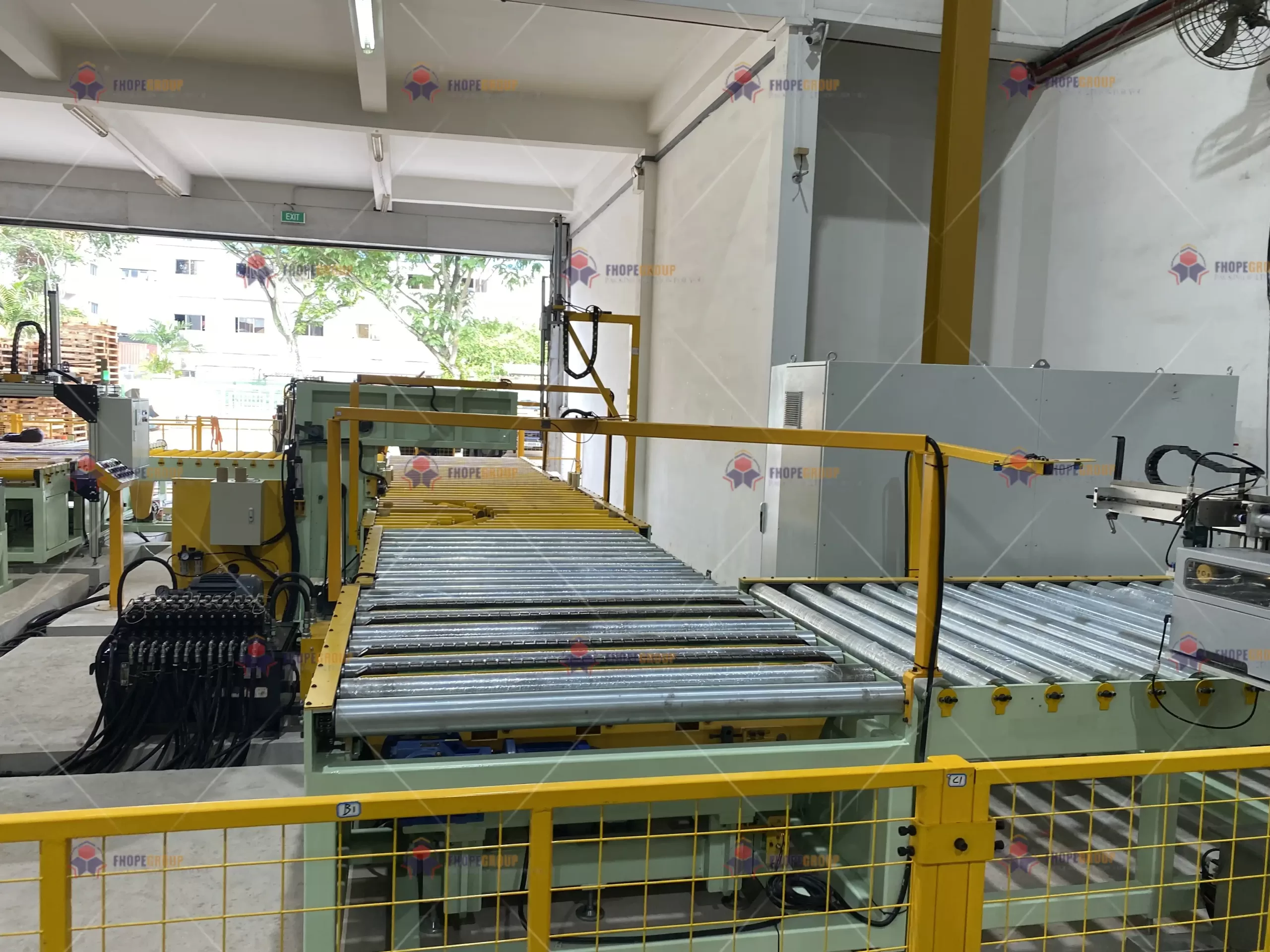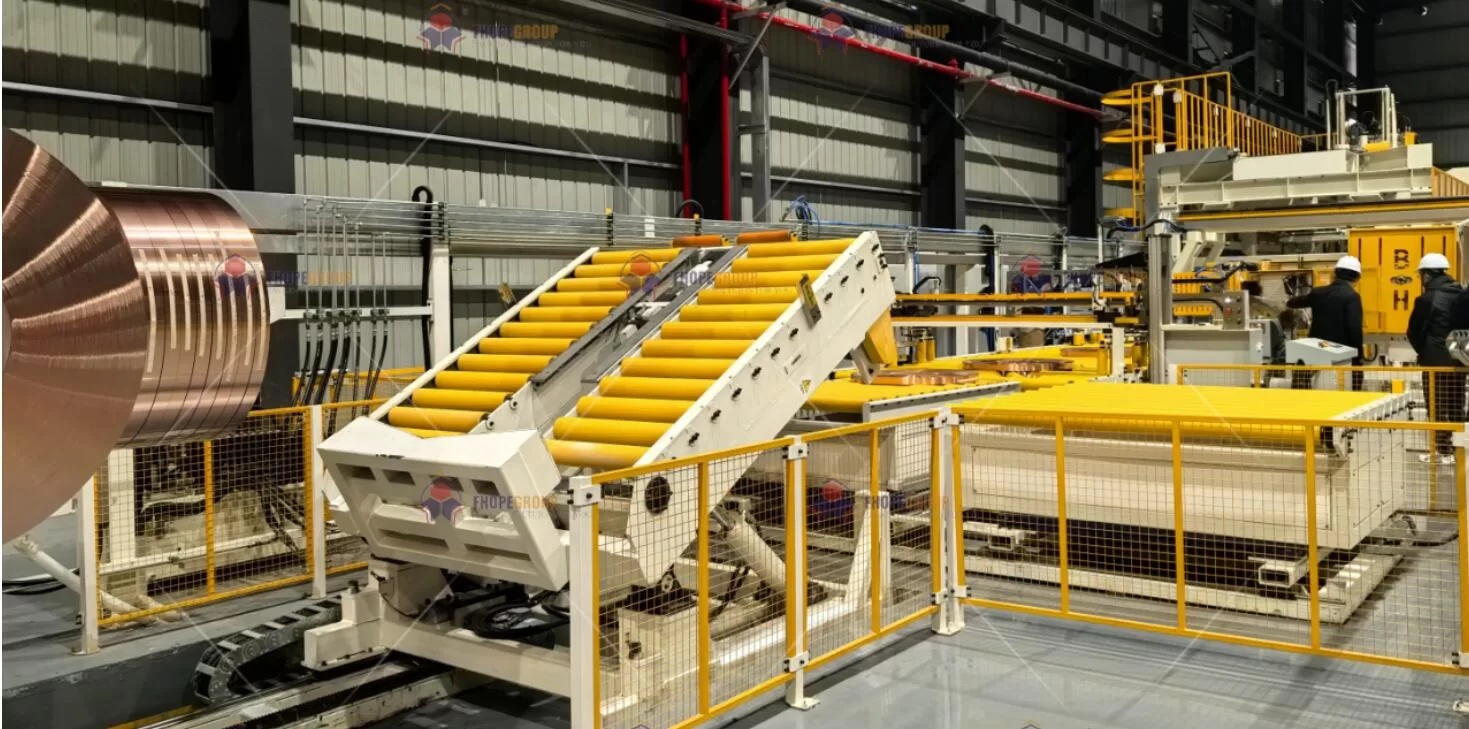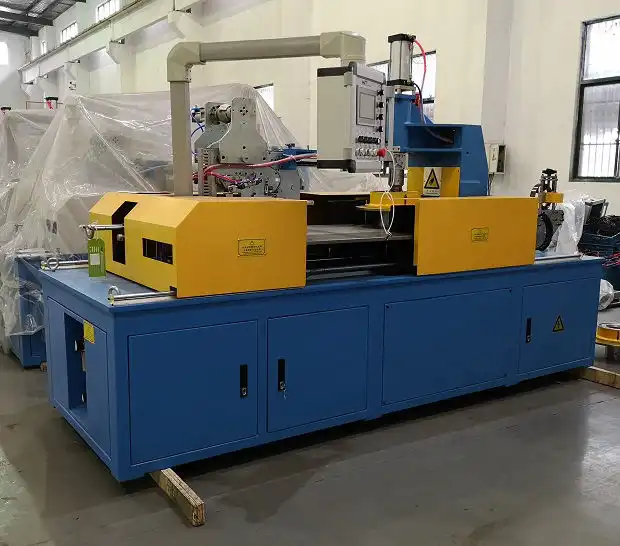How to Enhance Steel Coil Packing Line Security for Unattended Operations?
Imagine leaving your steel coil packing line running smoothly, even when no one’s around. Sounds risky, right? But with strategic security enhancements, unattended operations can become a reality, boosting productivity and reducing costs. The key is layering security measures that deter threats and protect your valuable assets.
Enhancing steel coil packing line security for unattended operations involves implementing robust access control, comprehensive surveillance systems, automated safety protocols, remote monitoring capabilities, and thorough cybersecurity measures to safeguard against unauthorized access and operational disruptions. This ensures continuous productivity and minimizes potential risks.
Ready to discover how to fortify your steel coil packing line and unlock the benefits of unattended operations? Keep reading to explore the essential security enhancements.

Hardening Access Control for Steel Coil Packing Lines
Leaving a steel coil packing line unattended requires stringent access controls to prevent unauthorized entry and tampering. Weak access control is a primary vulnerability for any unattended operation.
To harden access control, implement biometric authentication, multi-factor verification, and robust perimeter security. Integrate these measures with an alarm system and real-time monitoring to immediately detect and respond to unauthorized access attempts. This ensures only authorized personnel can access the packing line, mitigating risks associated with theft, sabotage, and operational disruptions.

Diving Deeper: Hazard Identification and Mitigation in Coil Packing
To effectively address the diverse risks in steel coil packing line unattended operations, a systematic approach to security measures is essential. This involves identifying vulnerabilities and analyzing potential dangers. By understanding where and how security can be breached, targeted security strategies can be implemented.
Assessing Vulnerabilities
A comprehensive vulnerability assessment forms the bedrock of any effective security program. It involves examining every stage of the unattended steel coil packing line operation, from automated systems to potential access points. The goal is to proactively identify potential vulnerabilities before they can be exploited.
This assessment should consider:
- Access Points: Evaluating all physical and digital entry points to the packing line.
- System Controls: Assessing the security features and potential malfunctions of automated systems.
- Remote Access: Analyzing the security of remote access protocols and devices.
By methodically analyzing these areas, a comprehensive vulnerability assessment provides the insights to develop targeted risk mitigation strategies.
Implementing Risk Mitigation Strategies: A Layered Approach
Once vulnerabilities are identified, the next crucial step is to implement mitigation strategies. These strategies should be layered, combining different approaches to create a robust security net. The following table outlines common vulnerability areas, potential risks, and effective mitigation strategies in steel coil packing line unattended operations:
| Risk Area | Potential Vulnerability | Mitigation Strategy |
|---|---|---|
| Physical Access | Unauthorized entry to the packing line | Biometric authentication, multi-factor verification, robust perimeter security, alarm systems |
| System Controls | Tampering with automated systems | Encrypted communication protocols, regular software updates, intrusion detection systems, access logs |
| Remote Access | Unauthorized remote access | VPNs, strong passwords, multi-factor authentication, session timeouts, regular security audits |
| Cybersecurity Threats | Malware, ransomware | Firewalls, antivirus software, intrusion prevention systems, employee training, regular backups |
| Data Transmission | Interception of sensitive data | Encryption, secure communication protocols, access controls, data loss prevention tools |
| Equipment Failure | Malfunctioning machinery | Regular inspections and maintenance schedules, remote diagnostics, emergency shutdown procedures, backup systems |
These mitigation strategies are not isolated solutions but interconnected components of a comprehensive security system.
Continuous Improvement Through Drills and Analysis
The effectiveness of security protocols is not static; it requires ongoing evaluation and improvement. Regular drills and thorough post-incident analysis are crucial for identifying weaknesses and enhancing the system.
- Realistic Drill Scenarios: Security drills should simulate realistic threat scenarios to test the entire response chain, from intrusion detection to incident reporting and system recovery.
- Performance Metrics and Analysis: Track key performance indicators during drills, such as response times and system reliability. Analyze drill outcomes and real incident reports to identify areas for improvement in protocols, training, or equipment.
- Feedback and Iteration: Solicit feedback from personnel involved in drills and actual incidents to gain insights into system usability and identify potential blind spots. Use this feedback to iteratively refine security protocols and training programs.
By embracing a continuous improvement approach, organizations can ensure their security protocols remain effective, adaptable, and truly contribute to a safer unattended environment.
Comprehensive Surveillance for Round-the-Clock Monitoring
A surveillance system is the cornerstone of any steel coil packing line unattended operations. It provides the ability to remotely monitor the equipment, and the surrounding environment.
Deploying a comprehensive surveillance system is essential. This includes high-resolution cameras with infrared capabilities, real-time video analytics for anomaly detection, and secure remote access for authorized personnel. Implement redundant recording systems and backup power to ensure continuous monitoring, even during power outages or system failures. Robust surveillance provides real-time visibility.
Deep Dive: Optimizing Surveillance Effectiveness in Coil Packing
Beyond the basic implementation of surveillance systems, optimizing their effectiveness involves a deeper consideration of human factors, technological integration, and continuous improvement processes.
Optimize Surveillance
Beyond the basic implementation of surveillance systems, optimizing their effectiveness involves deeper human factors, technological integration, and continuous improvement processes. The goal is to create a surveillance system that is functional but also intuitively used and consistently effective in real-world scenarios.
Implementing a remote real-time monitoring: Continuous monitoring during unmanned operation, including parameters such as real-time video feed and system performance data. In combination with advanced AI systems, which can be used to analyze real-time video and sensor data to detect anomalies or potential security breaches.
– Human-Centered Design of Surveillance Systems
Effectiveness is significantly influenced by their design and placement relative to human operators. Key considerations include:
- Ergonomic Accessibility: Displays should be positioned within easy reach from all operational areas, minimizing the time and effort required to respond during an emergency.
- Visual and Audible Alarms: Distinct signals, such as loud audible alarms and flashing visual indicators, should be triggered upon detecting intrusions to alert all personnel in the vicinity. Different signals for different alarms can further improve response clarity.
- Intuitive Operation: Activation should be straightforward and require minimal cognitive load.
– Camera Specification and Selection
Proper camera selection depends heavily on the monitoring environment. There are a few suggestions here.
- High Resolution Cameras with Infrared: Cameras that operate effectively in the dark are a must, the ability to see detail is critical.
- PTZ Cameras or Multiple Fixed Cameras: If detailed visual inspections are required, a PTZ is needed. However, blind spots should be minimized by using a mix of both fixed and PTZ.
– Continuous improvement Through Drills and Analysis
Drills and analysis are crucial for the system:
- Realistic Drill Scenarios: Drills are necessary to test the entire response chain.
- Performance Metrics and Analysis: Measuring the response time is necessary.
- Feedback and Iteration: Solicit feedback to gain valuable insights.
By embracing a continuous improvement approach, your surveillance system can remain effective and improve your coil packing line security.
Automated Safety Protocols for Immediate Response
Unattended operations require automated safety protocols that can react to emergencies without human intervention. Quick, reliable response is critical.
Automated safety protocols are essential. These include emergency shutdown systems triggered by sensor alerts, automated fire suppression, and robotic intervention for hazardous situations. Ensure these protocols are regularly tested and maintained, with clear procedures for remote override when necessary. By automating responses, you minimize damage and protect equipment and personnel.
Elevating Automated Safety: Proactive Measures and Reactive Systems
Automated systems need to be more than basic, a more elevated approach is needed to ensure worker safety. A combination of automated systems, sensors, and integration will give you that extra edge.
Remote Monitoring
Remote monitoring and control via a SCADA system provides real-time data and control capabilities for unmanned operations. The SCADA system collects and stores data and makes it accessible remotely, which helps to improve production efficiency.
Automated safety protocols for coil packing
| Automated safety protocols | Description | Importance |
|---|---|---|
| Remote monitoring and control via a SCADA system | Provides real-time data and control capabilities for unmanned operation. The SCADA system collects and stores data and makes it accessible remotely. | Increases production efficiency. Real-time data can help you make decisions and improve output. The remote access ensures you can have a team that can respond even in off times, and helps to reduce risks when operating the packing line without a team physically present. |
| Automated emergency shutdown | Automatically stops the machine when a problem is detected. Emergency shutdown is triggered by sensors, and designed to prevent damage to products. | Designed to ensure safety, protect products and other equipment from being damaged by emergencies such as equipment failure, power outage, or quality issues. This is one of the most important features during unmanned operation. |
| Use robots to minimize risks of the hazardous tasks and enhance efficiency of the operation | Use robots in place of human workers in hazardous, or repetitive tasks. This system is a critical solution for unmanned operation. | Reducing the potential hazards during heavy, high-risk tasks. The robots can minimize risks by taking the place of the human worker. Enhance the output of the packing line. |
| Automatic Fire suppression systems | These systems suppress a fire when it is detected, and quickly. | If the fire has been properly suppressed, it will prevent the fire from spreading out of control and causing significant property damage. |
| Periodic testing and preventative maintenance | Conduct routine tests, inspections, and preventative maintenance to reduce risks. | Identifying and resolving issues prior to any equipment failure, fire, or quality problems occurring. Conducting routine tests, inspections, and preventative maintenance to ensure the safety and reliability of all equipment. |
By investing in automated systems and preventative actions, unmanned operation of packing lines can be achieved in a safe and reliable manner.
Cybersecurity Safeguards for Data and System Integrity
In an increasingly digital world, cybersecurity is paramount for securing steel coil packing line unattended operations. Securing the data is just as important as the physical machinery.
Implement stringent cybersecurity measures to protect against hacking, malware, and unauthorized access to system controls. Deploy firewalls, intrusion detection systems, and regular security audits. Encrypt all data transmissions and implement multi-factor authentication for remote access. Robust cybersecurity ensures operational integrity and protects against data breaches.
Fortifying Digital Defenses: A Proactive Approach to Cybersecurity
Proactive and elevated security measures are needed to ensure maximum protection in the unmanned environment. Understanding the vulnerabilities and the latest advancements in cybersecurity can help you maintain peak security of your unmanned coil packing line.
- -Cybersecurity in unmanned coil packing line-
| Aspect | Suggestion | Importance |
|---|---|---|
| Network Segmentation | Segregate the control network from external networks to limit access points for attacks. | Reduce the attack surface by isolating critical systems from potential threats. |
| Intrusion Detection Systems (IDS) | Monitor network traffic and system logs for suspicious activity. | Provides real-time detection of unauthorized access attempts, malware infections, and other malicious activities. |
| Endpoint Protection | Use antivirus and anti-malware software on all computers and devices connected to the control network. | Minimize the risk of malware infections that could compromise system integrity and availability. |
| Data Encryption | Encrypt all data transmissions, both in transit and at rest, to protect sensitive information from unauthorized access. | Safeguard against data breaches and ensure confidentiality. |
| Incident Response Plan | Establish a well-defined incident response plan to address security breaches and system failures. | Ensure quick and effective responses to security incidents, minimizing downtime and mitigating potential damage. |
| Cybersecurity Awareness Training | Provide cybersecurity awareness training to all personnel, including engineers, operators, and IT staff. | Train employees on how to identify and avoid phishing attacks, malware, and other cybersecurity threats. |
| Regular Vulnerability Assessments | Conduct regular vulnerability assessments to identify weaknesses in the system. Conduct security audits and penetration tests periodically. | Regular checks will help maintain high levels of security, and help resolve new problems as soon as possible. |
| Software Updates | Apply software updates and patches promptly to address known vulnerabilities. | Keep systems secure by patching the system as quickly as possible after problems are identified, and resolve them before it gets exploited. |
| Access Control Policies | Implement stringent access control policies to restrict unauthorized access to sensitive systems and data. Use multi-factor authentication, and review the policies regularly. | Restricting unauthorized personnel and equipment from sensitive parts of the packing line. Limiting the potential for sabotage, theft, or other malicious activities. |
| Backup and Recovery Procedures | Establish regular backup and recovery procedures to ensure data integrity and system resilience. | Maintaining the packing lines operation is critical, and this can help prevent any disruption, while safely maintaining data in case a complete system takeover happens. |
Investing in cybersecurity best practices will yield a reliable, safe, and high-performing steel coil packing line. By taking the correct proactive actions you can significantly reduce your digital and physical risks.
Emphasizing Operational Oversight in Unattended Steel Coil Packing
While comprehensive systems and protocols are critical for secure unattended operations, it is also important to emphasize the importance of oversight by a designated safety team and remote monitoring tools.
Automated safety protocols and the utilization of Personal Protective Equipment (PPE) during steel coil packing and handling are essential for minimizing risk, preventing accidents, and creating a safe and productive working environment. By following these practices, steel manufacturers can better prevent accidents related to unsecured steel coils, and enhance overall workplace safety. Operational oversight requires a dedicated safety team, regular system audits, and clearly defined responsibilities for remote monitoring and troubleshooting. These measures minimize risks, improve system reliability, and ensure adherence to safety protocols, even without personnel on-site. This blend of automated systems and human oversight is key to a secure unattended steel coil packing line. By maintaining constant oversight, anomalies can be quickly identified and resolved, ensuring the safety of the system.
A comprehensive approach includes various components:
- Dedicated Safety Team: A core group to monitor the system is essential, and all involved should know who to contact during off hours or in the event of a system failure.
- Clearly Defined Responsibilities: Each team member should have pre-defined tasks to execute during an emergency or in the event of a system failure, minimizing confusion and speeding up response time.
- Communication System: Create a communication system which prioritizes critical information, and keeps all involved informed of the latest system status.
- Regular System Audits: Periodic audits are necessary to ensure that the automated safeguards are sufficient, and to examine the system for potential improvements. These audits will also highlight potential areas of concern before they can become real issues.
Overall, unattended steel coil packing lines are much safer with real-time oversight and analysis.
Conclusion
Enhancing steel coil packing line security for unattended operations demands a holistic approach. By implementing robust access control, comprehensive surveillance, automated safety protocols, and stringent cybersecurity measures, you can create a secure and efficient environment. This proactive strategy not only protects your assets and personnel but also maximizes productivity and minimizes operational disruptions during unattended operations. Prioritizing security now unlocks the full potential of unattended operations and sets the stage for a future of safer, more efficient manufacturing.
The future of steel coil packing relies on balancing innovation with proactive security measures, ensuring both productivity and safety.

